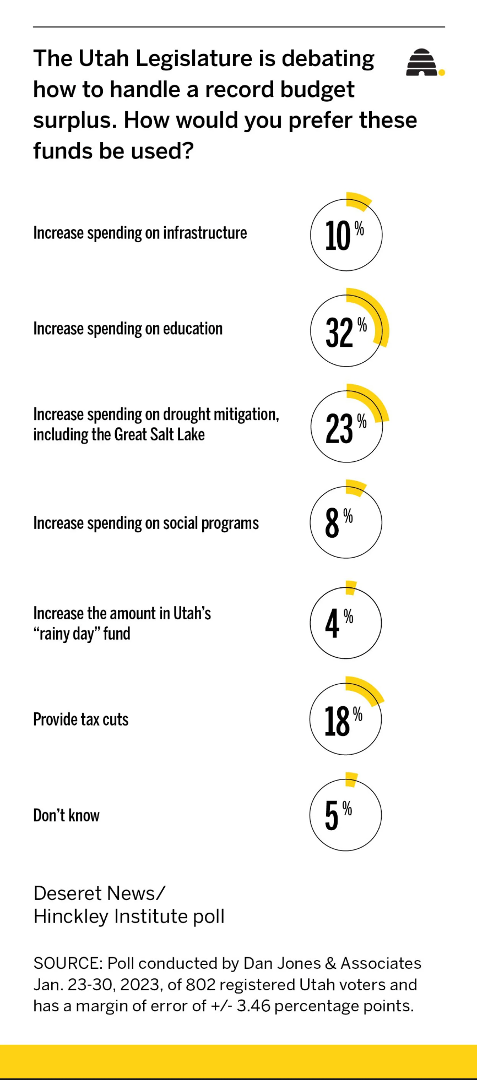The Legislature finished its 2023 General Session last Friday evening, March 3rd. In the area of tax policy, we've prepared the chart above to summarize the tax cuts passed this year.
The tax cuts that will go into effect in the next year add up to $408 million. Three-fifth of that amount goes to the highest-earning one-fifth of Utahns, and four-fifths goes to the top two-fifths. That leaves just one-fifth for the 60% of Utahns earning under $92,000. Unfortunately, these changes do nothing to improve the overall regressivity of Utah's current tax structure.
The picture improves slightly if we count the $200 million elimination of the state sales tax on unprepared food. Because the food tax is the most regressive element of our most regressive tax, removing it does reduce (but not eliminate) the regressivity in Utah's tax structure. (This part of HB 54 will only go into effect in 2025 if voters approve a Constitutional amendment ending the earmarking of income tax for education in November 2024. That earmark was broadened in 1996 to add higher education and again in 2020 via Amendment G to add all programs for children and for disabled Utahns to the permitted uses of income tax revenues.)
To clarify, we consider Utah's overall tax structure to be regressive because the highest income Utahns pay the lowest share of their incomes in state and local taxes, based on the analysis at www.ITEP.org/WhoPays/Utah.
We welcome the proposed elimination of the grocery tax and the reduced regressivity it would bring, especially since it benefits all low-income Utahns, including the considerable number who never file a tax return. We also welcome the much smaller but still beneficial impacts of the new non-refundable Child Tax Credit (CTC) and slightly expanded non-refundable Earned Income Tax Credit (EITC). Here are some specifics on those:
- Elimination of the $200 million state grocery tax reduces taxes on the lowest-income fifth of Utahns (those earning under $31,000) by $18 million, and it reduces taxes on the lowest-income two-fifths (those earning under $59,000) by a total of $48 million.
- The new Child Tax Credit (CTC) reduces taxes for those same two-fifths of Utahns by $9 million. It also makes Utah the 13th state with our own CTC, though NCSL's website indicates that ours will be one of just four that are non-refundable.
- The slightly expanded Utah EITC adds a reduction of $1 million for the low- and moderate-income 40% of Utahns. Sadly, it still excludes the lowest-income 80-90% of Utah's federal EITC recipients because it remains non-refundable.
Those three tax reductions add up to $58 million for low- and moderate-income Utahns, which means that less than 10% of the overall tax cut reaches the 40% of the population that needs it most. (For more about why refundability is critical for the effectiveness of family tax credits like the ETC and CTC, please visit https://www.utahfamilytaxcredits.org/learnmore/.)
Unfortunately, the majority of the $608 million in tax cuts goes to Utahns earning six-figure incomes, who neither need nor are asking for tax cuts. In fact, the survey conducted during the legislative session by the Deseret News and Hinckley Institute found that just 18% of Utahns wanted a tax cut. The overwhelming majority supported investing more in education, infrastructure, saving the Great Salt Lake, and other building blocks of Utah's future prosperity and success:

This result is consistent with previous polling on the question of whether Utah should be cutting taxes. Previous polls include....
- Deseret News/Hinckley Institute 2022
- Deseret News/Hinckley Institute 2021
- Deseret News/Hinckley Institute 2020
- Utah Foundation 2020
- Envision Utah 2020
Clearly the public is more concerned than Utah's political leaders about the billions of dollars in unmet needs identified by the Invest In Utah's Future coalition. The public is probably also aware of the two biggest problems with cutting the income tax:
- Cutting the income tax leads to higher property taxes as the local districts struggle to make up the lost education revenues. And in fact, the last 14 years have seen inflation-adjusted per-student local education revenue (from property taxes) rise 12% while inflation-adjusted per-student state funding (from the income tax) fell 2.5%. Given the spike in local property taxes in the last year or two, it was disappointing to see that the Legislature failed to pass even very modest measures like HB 260 that would have devoted $5 million to expand eligibility for the state's property tax relief programs to more low- and moderate-income households.
- Cutting $400 million from the income tax breaks down to well over $500 per student diverted from the main source of education funding. For the median income family of four, they gain about $200 in tax cuts -- but lose over $1,000 that now will not be invested every year in their own kids' education.
Unfortunately, the Utah Legislature has proven once again that it is all too ready to give in to the tax cut temptation, even though Utah already has the 7th lowest taxes in the nation according to WalletHub, and despite the fact that we are already a top 10 state nationally for our business-friendly taxes, according to the Tax Foundation.
***** ***** ***** ******
WE'VE POSTED A VIDEO WALK-THROUGH OF THE CHART ABOVE AT https://fb.watch/jcAUe4-Rqr/






